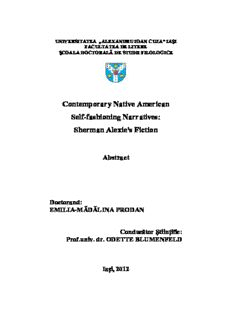
Contemporary Native American Self-fashioning Narratives: Sherman Alexie's Fiction PDF
Preview Contemporary Native American Self-fashioning Narratives: Sherman Alexie's Fiction
UNIVERSITATEA ,,ALEXANDRU IOAN CUZA” IAŞI FACULTATEA DE LITERE ŞCOALA DOCTORALĂ DE STUDII FILOLOGICE Contemporary Native American Self-fashioning Narratives: Sherman Alexie’s Fiction Abstract Doctorand: EMILIA-MĂDĂLINA PRODAN Conducător Ştiinţific: Prof.univ. dr. ODETTE BLUMENFELD Iași, 2012 Table of Contents Acknowledgements………………………… 1 List of Abbreviations...…………………… 2 Table of Contents………………………….. 3 Introduction………………………………... 7 Chapter 1: (Mis)Representations of Native Americans in the Dominant Discourse…… 13 1.1 Diachronic Mainstream Representations of Native Americans………. 13 1.1.1 The Dynamics of Self and Other in Colonialist Literature…………….................. 13 1.1.1.1 The Puritan Projection of the Indian Other…………………………….................... 17 1.1.2 Appropriation of Indianness………… 18 1.1.3 Constructing the Indian in the Written Text...........……………………...................... 19 1.1.3.1 The “Discovery” of America and of the Indian……………………………………. 19 1.1.3.2 The “Authentic” Accounts of the Colonial Period……………………………... 24 1.1.3.3 Captivity Narratives………………… 26 1 1.1.3.4 Literary Versions of Manifest Destiny………………………………….…... 28 1.1.4 The Imaginary Indian……………….. 33 1.1.4.1 The Noble Savage…………... 35 1.1.4.2 The Ignoble Indian………….. 37 1.1.4.3 The Vanishing Indian……….. 39 1.2 Visual Mainstream Representations of the Native Americans……………............. 41 1.2.1 Perpetuation of Stereotypes in Films. 41 1.2.2 Stereotyping the Indian……………... 46 1.2.2.1 The Stoic Warrior…………… 47 1.2.2.2 The Wise Elder……………… 49 1.2.2.3 The Vanishing Indian……….. 51 1.2.3 Stereotypical Representations of Native American Women………………........ 55 1.2.3.1 The Squaw Drudge………….. 58 1.2.3.2 The Sexualized Maiden……... 60 1.2.3.3 The Indian Princess…………. 62 1.2.3.3.1 Pocahontas on Display……… 63 1.2.3.a New Age Feminism…………………. 65 1.2.4 Miscegenation – The Long-standing 2 Hollywood Taboo…………………………... 66 1.2.5 Who Gets to Play the Indian?............. 70 1.2.6 The Presence of Stereotypes in the History of the American Film………………. 72 1.2.6.1 The Silent Era……………….. 73 1.2.6.2 The Western in the 1930s and 1940s………………………………………... 75 1.2.6.3 The “Revisionistic” Western... 78 1.2.6.4 The Television Friendly Indian……………………….......................... 80 1.2.6.5 The Western in the 1990s…… 83 Chapter 2: Narratives of Conquest in Sherman Alexie’s Writing – White Prescriptions on Red Bodies………………. 87 2.1 Colonizing the Native Mind – Stories of Assimilation in Indian Killer, Reservation Blues and Short Stories ……………………. 88 2.1.1 The Trauma of Colonization………... 93 2.1.2 Defining Authentic Indianness……… 98 2.1.2.1 Appropriating Indianness…………… 105 2.1.2.2 Native Counteracting: Appropriating 3 Whiteness…………………………………… 112 2.1.3 Authenticity and Commodification in Reservation Blues…………………………… 113 2.2 Challanging the Colonialist Power Structures through Inverted Magic Realism 127 in Reservation Blues………………………… 2.2.1.1 Whiteness as Magic………… 128 2.2.1.2 Indianness as Non-magic…… 132 Chapter 3: Counter-narratives – Revision and Subversion of Mainstream Narratives in Sherman Alexie’s Short Stories……… 136 3.1 Gerald Vizenor’s Manifest Manners... 136 3.2 Narratives of Survivance.. ………….. 138 3.2.1 Approaches to Storytelling and Its Purposes…………………………………….. 139 3.2.1.1 The Narrative Perspective…………... 144 3.2.1.2 The Power of Storytelling…………... 147 3.2.1.2.1 Rewriting History…………… 147 3.2.1.2.2 Changing/Challenging Reality through Imagination………………………… 150 3.2.1.2.3 Preserving Tradition………… 151 4 3.2.1.2.4 Imagination as a Weapon…… 153 3.2.2 Traveling Upriver with the Salmon – Tradition and Survivance…………………… 154 3.2.3 Survivance and Popular Culture……. 157 3.2.4 Visual Narratives of Survivance……. 162 3.2.4.1 Redefining the Cinematic Indian in Smoke Signals………………………............. 162 3.3 Postindian Warriors of Survivance…. 168 3.3.1 Violence, Alcohol and the Crazy Horse Warriors……………………………… 170 3.3.2 Seymour Polatkin and the Third Space………………………………………... 178 3.3.3 Thomas Builds-the-Fire: A Contemporary Storyteller…………………… 186 3.3.4 Postindian Women Warriors………... 192 Chapter 4: Repositioning Indianness in the Context of Interethnic Reconciliation... 197 4.1 Renegotiating White-Indian Interactions in Ten Little Indians…………… 198 4.1.1 Reinventing the Indian in the Urban Context……………………………………… 198 5 4.1.2 Polycultural Alliances ………………. 203 4.1.3 Adapting Ceremonies…….…………. 206 4.2 Mixed-blood Identity in Flight……... 209 Chapter 5: Mechanisms and Functions of Humor in Sherman Alexie’s Texts.............. 223 5.1 Theoretical Approaches to Humor….. 224 5.2 Humor in Native American Literature 226 5.3 Forms of Humor in Sherman Alexie’s Texts………………………………………… 230 5.3.1 Survival Humor and Gallows Humor………………………………………. 230 5.3.2 Irony………………………………. 233 5.3.3 Sarcasm…………………………… 238 5.3.4 Satire……………………………… 241 5.3.5 Parody…………………………….. 244 5.3.6 Burlesque…………………………. 246 5.3.7 Wordplay and Punning……………. 247 5.4 Functions of Humor in Sherman Alexie’s Texts………………………………. 250 Conclusions…………………………….…… 255 Works Cited………………………………… 263 6 Primary Sources…………………………… 263 Sherman Alexie’ s Texts………….……… 263 Other Texts……………………………..... 264 Filmography ………………….…… 266 General Secondary Literature……………... 268 Secondary Literature on Sherman Alexie…. 279 List of Illustrations……………..………….. 285 Key-words Native American, film, (mis)representation, stereotype, identity, dominant discourse, survivance, gender, storytelling, authenticity, appropriation, assimilation, tradition, commodification, ethnic reconciliation, mixed- blood, humor 7 Abstract The contemporary multicultural model in the United States affirms, reassesses and gives ethnic minorities the opportunity to gain their proper place in the American mainstream culture. The dynamics and the structure of the American literature have changed, so it can be said that there is no longer a single, unitary ideology and direction in literature. Rather, there are several literatures which are emerging according to different perspectives that range from the ethnic minority to the gender minority perspective, both of them being sometimes included in the same narrative. Thus, the previously marginalized minorities (according to ethnicity, gender, etc.), gain access to the cultural center and have the opportunity to make their voice heard, as opposed to the previous silencing and misrepresentation. In this context, the aim of the thesis entitled Contemporary Native American Self- fashioning Narratives: Sherman Alexie’s Fiction 8 is to assess the works of contemporary Native American writer Sherman Alexie by employing several theoretical approaches: postcolonial studies, as well as cultural studies (ethnic studies and film studies) in order to offer a comprehensive analysis of his texts, on the one hand, and to position his writing in the social and cultural milieu from which it originates, on the other hand. Sherman Alexie’s texts are self- fashioning narratives which subvert and revise the misrepresentations of Native Americans which permeate American literature and film, repositioning Indianness in the twenty-first polycultural America. In order to assess Alexie’s texts, an examination of the misrepresentations of Native Americans in the American culture is imperative. Therefore, the first chapter, entitled (Mis)Representations of Native Americans in the Dominant Discourse focuses on the diachronic analysis of the representations of Indianness in literature and film. Representations of Native 9
Description: